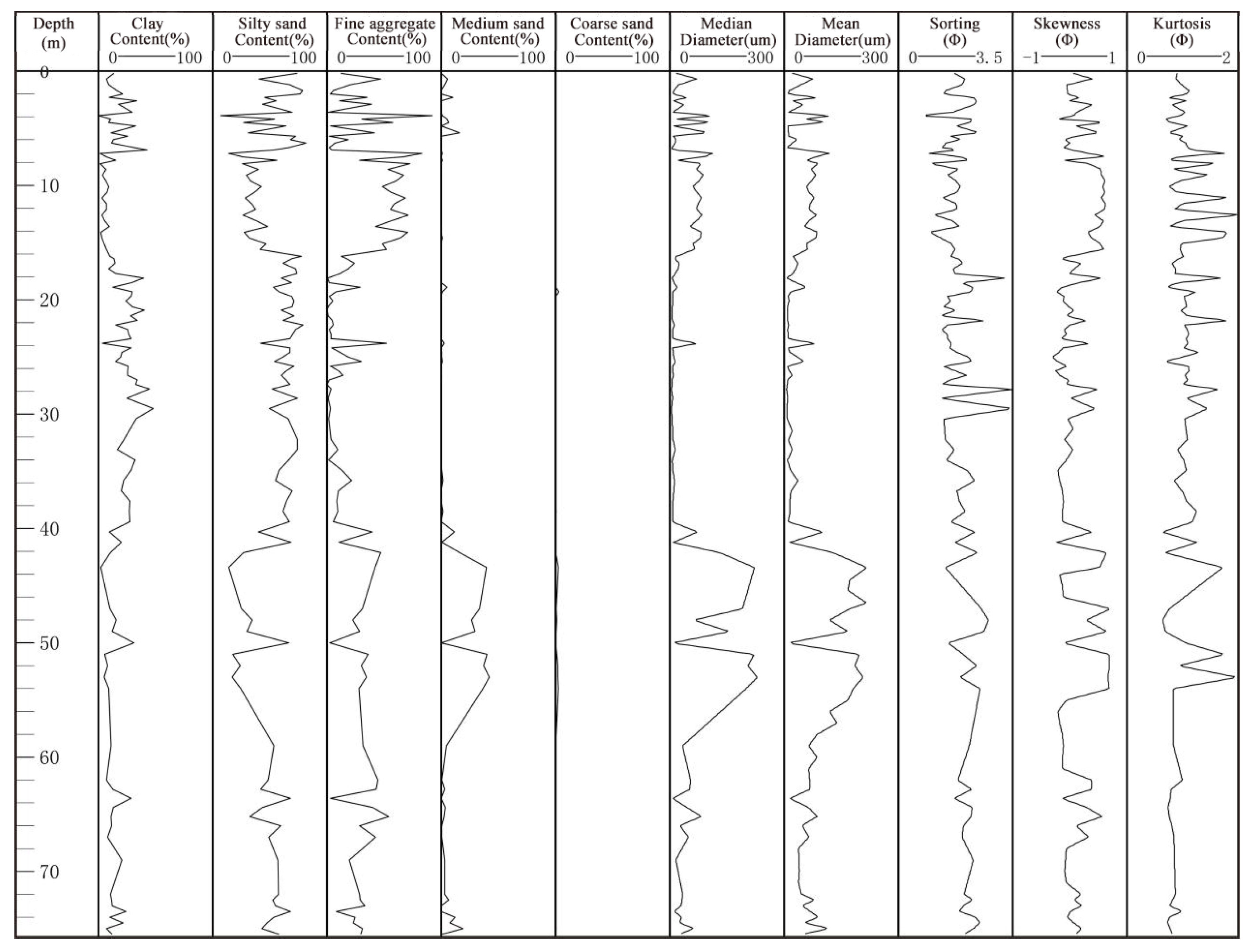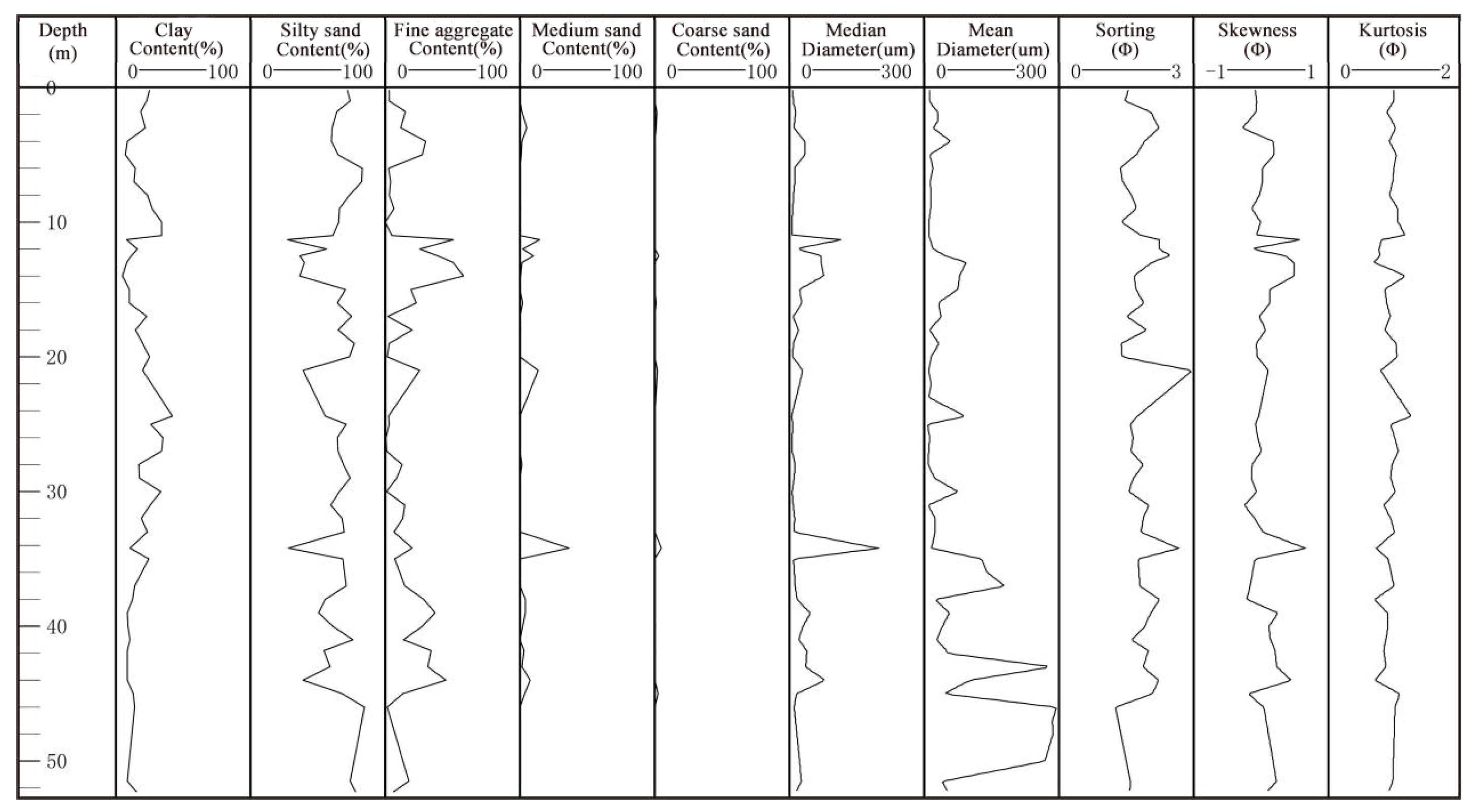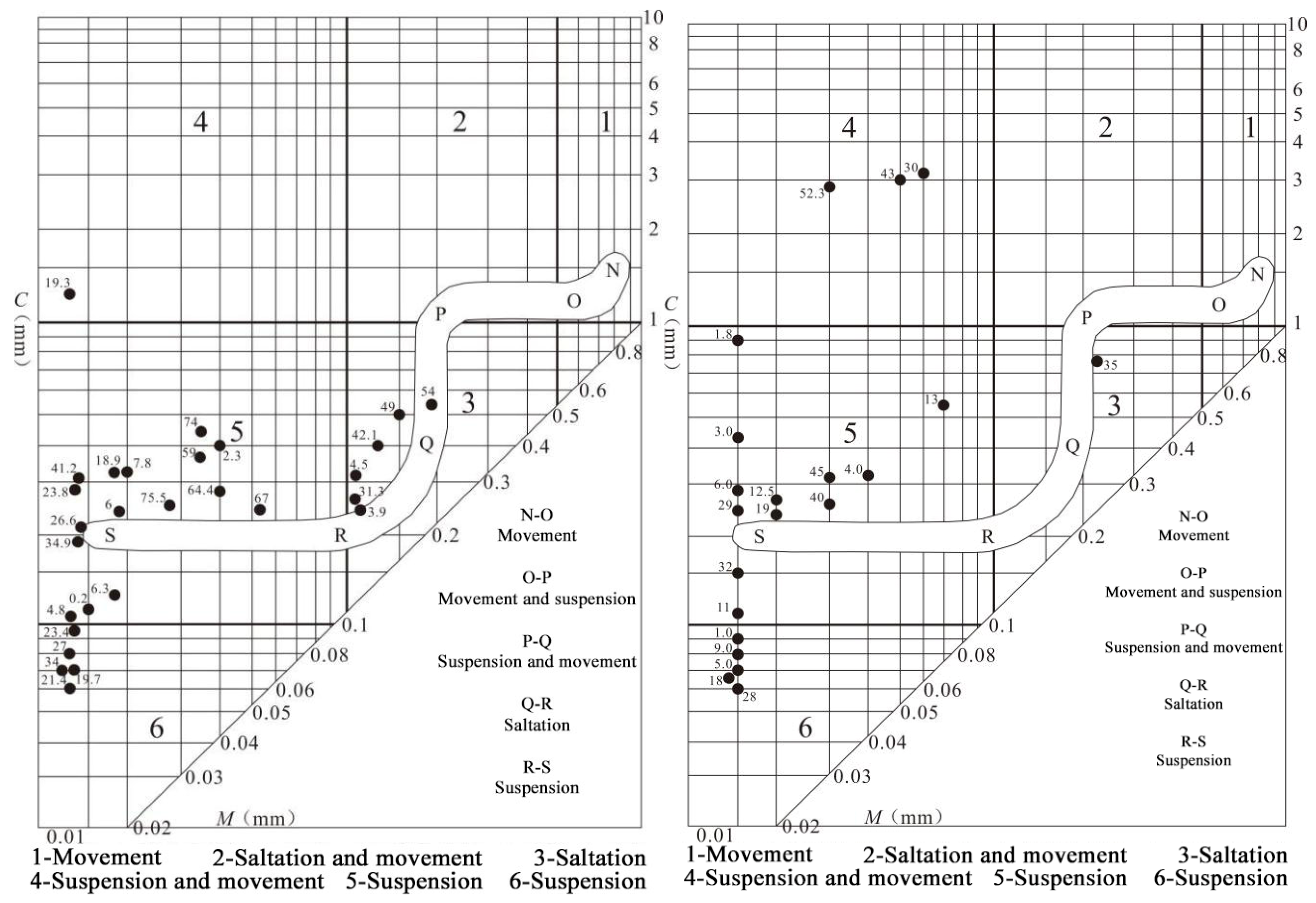Study on Sedimentary Evolution of the Hanjiang River Delta during the Late Quaternary
Abstract
:1. Introduction
2. Materials and Methods
2.1. Geological Context of the Study Area
2.2. Research Material
2.3. Experimental Method
2.3.1. Age Determination
- AMS 14C
- 2.
- OSL age
2.3.2. Microfossil Analysis
2.3.3. Grain Size Test
3. Results
3.1. Strata Age
3.2. Abundance of Foraminifera and Ostracods
3.3. Particle Size Analysis
4. Discussion
4.1. Age of Earliest Acceptance of Quaternary Sediments: MIS 3 or MIS 5
4.2. Sedimentary Evolution Process
4.3. Holocene Delta Formation and Barrier–Lagoon System
5. Conclusions
- (1)
- The study area began to accept Quaternary sediments in the early Late Pleistocene (MIS5). A total of 10 sedimentary units developed from the bottom to the top of the Late Quaternary sediments, which mainly experienced a floodplain environment and estuary–beach environment in the early Late Pleistocene; a floodplain environment, coastal shallow sea environment, bar–lagoon environment, coastal shallow sea environment, and floodplain environment in the middle and late Pleistocene; and an estuary environment, bar–lagoon environment and delta sedimentary environment in the Holocene. From bottom to top, the study area is mainly divided into three sedimentary cycles. Each sedimentary cycle shows a sedimentary rhythm from coarse to fine from bottom to top, starting with medium and coarse sand or gravel deposition and ending with muddy silt or clay deposition. The first and second cycles belong to the late Pleistocene, and the third cycle belongs to the Holocene.
- (2)
- After the maximum transgression in the Holocene, the progradation rate of the Hanjiang River Delta was fast, and increasing amounts of sediments converged to the sea through the third row of island mounds. Under the dynamic marine background of weak tidal action and strong wave action in the bay, coupled with the blocking effect of the third island mound in the bay, the sediments imported into the open sea were redistributed along both sides of the estuary and parallel to the coastline, forming a series of barrier–lagoon systems. With the continuous construction of the delta, the lagoon water body was filled with delta deposits, and the barrier bar moved to the sea. In this cycle, the study area developed a unique barrier–lagoon coastal delta deposit.
Author Contributions
Funding
Acknowledgments
Conflicts of Interest
References
- Stanley, D.J.; Warne, A.G. Worldwide initiation of Holocene marinedeltas by Decelera-tion of sea-level rise. Science 1994, 265, 228–231. [Google Scholar] [CrossRef] [PubMed]
- Maloney, J.M.; Bentley, S.J.; Xu, K.; Obelcz, J.; Georgiou, I.Y.; Miner, M.D. Mississippi River subaqueous delta is entering a stage of retrogradation. Mar. Geol. 2018, 400, 12–23. [Google Scholar] [CrossRef]
- Sun, Z.; Li, G.; Yin, Y. The Yangtze River deposition in southern Yellow Sea during Marine Oxygen Isotope Stage 3 and its implications for sea-level changes. Quat. Res. 2015, 83, 204–215. [Google Scholar] [CrossRef]
- Galloway, W.E. Process framework for describing the morphologic and stratigraphic evolution of deltaic depositional systems. Houst. Geol. Soc. 1975, 87–98. [Google Scholar]
- Bard, E.; Hamelin, B.; Arnold, M.; Montaggioni, L.; Cabioch, G.; Faure, G.; Rougerie, F. Deglacial sea-level record from Tahiti corals and the timing of global meltwater discharge. Nature 1996, 382, 241–244. [Google Scholar] [CrossRef]
- Fan, D.; Wu, Y.; Zhang, Y.; Burr, G.; Huo, M.; Li, J. South Flank of the Yangtze Delta: Past, present, and future. Mar. Geol. 2017, 392, 78–93. [Google Scholar] [CrossRef]
- Zhang, Q.; Liu, C.; Zhu, C. Impact of environmental changes on human activities during the holocene in the Changjiang (Yangtze) river delta region. Mar. Geol. Quat. Geol. 2004, 24, 9–15. [Google Scholar]
- Wang, Z.; Saito, Y.; Zhan, Q.; Nian, X.; Pan, D.; Wang, L.; Chen, T.; Xie, J.; Li, X.; Jiang, X. Three-dimensional evolution of the Yangtze River mouth, China during the Holocene: Impacts of sea level, climate and human activity. Earth-Sci. Rev. 2018, 185, 938–955. [Google Scholar] [CrossRef]
- Han, M.K.; Wu, L.; Liu, Y.F.; Mimura, N. Impacts of sea-level rise and human activities on the evolution of the pearl River Delta, South China. Proc. Mar. Sci. 2000, 2, 237–246. [Google Scholar]
- Zhang, H. Faulting and the Formation and Development of Hanjiang Delta. Acta Oceanol. Sin. 1983, 5, 202–211. [Google Scholar]
- Chen, G. Preliminary understanding of the Holocene transgression and regression in the Hanjiang and Rongjiang rever deltas. Mar. Sci. Bull. 1984, 3, 39–44. [Google Scholar]
- Li, P.R.; Huang, Z.G.; Zong, Y.Q. Hanjiang Delta; China Ocean Press: Beijing, China, 1987. [Google Scholar]
- Sun, J.-l.; Xu, H.L.; Wu, P.; Wu, Y.-B.; Qiu, X.-L.; Zhan, W.-H. Late Quaternary sedimentological characteristics and sedimentary environment evolution in sea area between Na’ao and Chenghai, eastern Guangdong. J. Trop. Oceanogr. 2007, 26, 30–36. [Google Scholar]
- Cao, Q. Characteristics of Palaeoceanographical and Palaeoenvironmental Evolution since the Pleistocene in the Okinawa Trough; The Institute of Oceanology, Chinese Academy of Sciences: Beijing, China, 2002. [Google Scholar]
- Lea, D.W.; Martin, P.A.; Pak, D.K.; Spero, H.J. Reconstructing a 350 ky History of Sea Level Using Planktonic Mg/Ca and Oxygen Isotope Records from a Cocos Ridge Core. Quat. Sci. Rev. 2002, 21, 283–293. [Google Scholar] [CrossRef]
- Fairbridge, R.W. Eustatic changes in sea level. Phys. Chem. Earth 1961, 4, 99–185. [Google Scholar] [CrossRef]
- Siddall, M.; Rohling, E.J.; Almogi-Labin, A.; Hemleben, C.; Meischner, D.; Schmelzer, I.; Smeed, D.A. Sea-level fluctuations during the last glacial cycle. Nature 2003, 423, 853–858. [Google Scholar] [CrossRef] [PubMed]
- Zhao, B.; Wang, Z.; Chen, J.; Chen, Z. Marine sediment records and relative sea level change during Late Pleistocene in the Changjiang delta area and adjacent continental shelf. Quat. Int. 2008, 186, 164–172. [Google Scholar] [CrossRef]
- Zong, Y.Q. Postglacial Stratigraphy and Sea-Level Changes in the Han River Delta, China. J. Coast. Res. 1992, 8, 1–28. [Google Scholar]
- Nguyen, V.L.; Ta, T.; Saito, Y. Early Holocene initiation of the Mekong River delta, Vietnam, and the response to Holocene sea-level changes detected from DT1 core analyses. Sediment. Geol. 2010, 230, 146–155. [Google Scholar] [CrossRef]
- Hori, K.; Saito, Y. An early Holocene sea-level jump and delta initiation. Geophys. Res. Lett. 2007, 34, L18401. [Google Scholar] [CrossRef]






| Borehole Number | Depth/m | Dating Materials | Average Calendar Age/ka BP | Error/ka |
|---|---|---|---|---|
| ZK03 | 34.5 | mud | 24.1 | ±0.18 |
| ZK03 | 37.5 | mud | 27.9 | ±0.26 |
| ZK03 | 39.7 | mud | 37.4 | ±0.70 |
| HK01 | 2 | foraminiferan | 2.4 | ±0.03 |
| HK01 | 8.5 | mud | 8.1 | ±0.05 |
| HK01 | 24.3 | mud | 30.2 | ±0.31 |
| HK03 | 3 | foraminiferan | 3.2 | ±0.04 |
| HK03 | 5.2 | foraminiferan | 5.0 | ±0.04 |
| Borehole Number | Depth/m | Dating Materials | Age/ka BP | Error/ka |
|---|---|---|---|---|
| ZK03 | 40.9 | Grey medium fine sand | 55.8 | ±5.8 |
| ZK03 | 64.7 | Dark gray argillaceous fine sand | 96.7 | ±13 |
| ZK03 | 74.1 | Bluish gray muddy silty sand | 74.2 | ±8.2 |
| ZK01 | 38.0 | Grayish yellow medium sand | 52.6 | ±7.5 |
| HK01 | 26.1 | Dark gray medium sand | 17.3 | ±2.3 |
| HK01 | 33.1 | Dark gray sandy clay | 55.9 | ±6.1 |
| ZK02 | 21.8 | Dark gray medium fine sand | 67.2 | ±5.3 |
| HK05 | 13.5 | Grayish yellow sandy clay | 16.2 | ±1.9 |
| Sample Number | Depth/(m) | Number of Shell Statistics | Bonded shell | Porcelain Shell | Calcium Transparent Shell | ||||||||||||||||||||||||||||||||
|---|---|---|---|---|---|---|---|---|---|---|---|---|---|---|---|---|---|---|---|---|---|---|---|---|---|---|---|---|---|---|---|---|---|---|---|---|---|
| Textularia sp. | Textularia foliacea | Spiroloculina sp. | Quinqueloculina laevigata | Quinqueloculina seminula | Quinqueloculina lamarckiana | Quinqueloculina akneriana | Quniqueloculina sp. | Massilina laevigata | Triloculina tricarinata | Flintina bradyana | Guttulina sp. | Glandulina sp. | Cibicides sp. | Hanzawaia nipponica | Hanzawaia convex | Rotalidium annectens | Rotalinoides compressiusculus | Ammonia beccarii var. | Ammnoia spp. | Ammonia tepida | Asterorotalia substrispinosa | Asterorotalia diplocava | Asterorotalia binhaiensis | Eponides sp. | Rosalina bradyi | Pararotalia inermis | Pseudorotalia schroeteriana | Cribrononion subincertum | Elphidium advenum | Elphidium hispidulum | Elphidium sp. | Elphidium crispum | Nonion commune | Nonion sp. | |||
| ZK03 | 17 | 25 | 0 | 0 | 0 | 2 | 0 | 0 | 0 | 2 | 0 | 0 | 0 | 0 | 0 | 0 | 0 | 0 | 0 | 0 | 4 | 5 | 0 | 4 | 0 | 0 | 0 | 0 | 1 | 0 | 0 | 2 | 0 | 4 | 0 | 1 | 0 |
| ZK03 | 25 | 385 | 0 | 0 | 0 | 2 | 0 | 2 | 2 | 5 | 1 | 0 | 0 | 0 | 0 | 0 | 0 | 0 | 2 | 0 | 6 | 11 | 2 | 321 | 3 | 5 | 0 | 0 | 2 | 0 | 1 | 7 | 0 | 9 | 0 | 2 | 2 |
| ZK03 | 27 | 115 | 0 | 0 | 0 | 0 | 0 | 0 | 0 | 1 | 0 | 0 | 0 | 0 | 0 | 0 | 0 | 0 | 0 | 0 | 5 | 18 | 0 | 78 | 2 | 2 | 0 | 0 | 2 | 0 | 0 | 2 | 0 | 5 | 0 | 0 | 0 |
| ZK03 | 29 | 33 | 0 | 0 | 0 | 0 | 0 | 0 | 0 | 0 | 0 | 0 | 0 | 0 | 0 | 0 | 0 | 0 | 0 | 0 | 11 | 14 | 0 | 1 | 0 | 0 | 0 | 0 | 0 | 0 | 0 | 3 | 0 | 4 | 0 | 0 | 0 |
| ZK03 | 34.5 | 48 | 0 | 0 | 0 | 0 | 0 | 0 | 0 | 0 | 0 | 0 | 0 | 0 | 0 | 0 | 0 | 0 | 0 | 0 | 0 | 3 | 0 | 36 | 0 | 2 | 0 | 0 | 0 | 1 | 0 | 3 | 0 | 2 | 1 | 0 | 0 |
| HK03 | 3 | 101 | 0 | 0 | 1 | 2 | 0 | 11 | 1 | 24 | 5 | 0 | 0 | 0 | 0 | 0 | 0 | 0 | 1 | 0 | 0 | 0 | 0 | 0 | 0 | 0 | 4 | 0 | 16 | 18 | 0 | 7 | 2 | 6 | 3 | 0 | 0 |
| HK03 | 5.2 | 355 | 1 | 1 | 6 | 13 | 2 | 62 | 11 | 47 | 32 | 3 | 2 | 1 | 0 | 2 | 0 | 2 | 64 | 4 | 7 | 6 | 0 | 0 | 0 | 0 | 8 | 0 | 12 | 0 | 0 | 22 | 5 | 12 | 5 | 16 | 11 |
| HK01 | 2 | 411 | 0 | 0 | 2 | 12 | 2 | 33 | 5 | 14 | 4 | 2 | 0 | 0 | 2 | 3 | 3 | 0 | 188 | 1 | 2 | 4 | 0 | 0 | 0 | 0 | 0 | 1 | 0 | 0 | 0 | 14 | 5 | 9 | 1 | 92 | 12 |
| HK01 | 4 | 280 | 0 | 0 | 2 | 13 | 1 | 31 | 9 | 17 | 1 | 4 | 2 | 0 | 0 | 4 | 2 | 0 | 63 | 2 | 3 | 5 | 1 | 0 | 0 | 0 | 0 | 1 | 0 | 0 | 0 | 25 | 26 | 17 | 4 | 36 | 11 |
| HK06 | 10.3 | 9 | 0 | 0 | 0 | 0 | 0 | 0 | 0 | 0 | 0 | 0 | 0 | 0 | 0 | 0 | 0 | 0 | 0 | 1 | 1 | 1 | 0 | 1 | 0 | 0 | 0 | 0 | 0 | 0 | 0 | 3 | 0 | 2 | 0 | 0 | 0 |
| Drilling Number | Depth/m | Sinocytheridea longa | Sinocytheridea impressa | Albileberis sinensis | Albileberis sp. | Sinocytheridea sp. | Pontocythere minuta | Stigmatocythere costa | Stigmatocythere roesmanisis | Bicornucythere bisanensis | Neonomoceratina delicata | Neomonoceratina chenae | Keijella kloempritensis | Keijella bisanensis | Neocytheretta faceta | Pistocythereis sp. | Pistocythereis subovata |
|---|---|---|---|---|---|---|---|---|---|---|---|---|---|---|---|---|---|
| ZK03 | 17 | 0 | 0 | 1 | 0 | 0 | 0 | 0 | 0 | 0 | 0 | 0 | 0 | 0 | 0 | 0 | 0 |
| ZK03 | 25 | 3 | 1 | 0 | 0 | 1 | 1 | 0 | 0 | 3 | 2 | 2 | 1 | 0 | 0 | 0 | 0 |
| ZK03 | 27 | 0 | 0 | 0 | 0 | 0 | 0 | 0 | 0 | 2 | 0 | 0 | 0 | 0 | 0 | 0 | 0 |
| ZK03 | 29 | 0 | 0 | 0 | 0 | 0 | 0 | 0 | 0 | 1 | 0 | 0 | 0 | 0 | 0 | 0 | 0 |
| ZK03 | 34.5 | 17 | 22 | 8 | 2 | 1 | 0 | 0 | 2 | 4 | 3 | 4 | 3 | 2 | 2 | 4 | 2 |
| HK03 | 3 | 3 | 1 | 0 | 0 | 0 | 1 | 0 | 0 | 2 | 0 | 1 | 0 | 0 | 0 | 0 | 0 |
| HK03 | 5.2 | 47 | 8 | 1 | 3 | 4 | 0 | 1 | 1 | 6 | 4 | 7 | 2 | 3 | 2 | 1 | 2 |
| HK01 | 2 | 17 | 15 | 8 | 16 | 14 | 3 | 3 | 5 | 21 | 13 | 14 | 13 | 18 | 15 | 9 | 17 |
| HK01 | 4 | 14 | 6 | 2 | 4 | 4 | 0 | 0 | 0 | 5 | 7 | 4 | 5 | 2 | 4 | 6 | 16 |
| HK06 | 10.3 | 1 | 2 | 2 | 0 | 0 | 0 | 0 | 0 | 0 | 1 | 1 | 0 | 0 | 0 | 0 | 0 |
Disclaimer/Publisher’s Note: The statements, opinions and data contained in all publications are solely those of the individual author(s) and contributor(s) and not of MDPI and/or the editor(s). MDPI and/or the editor(s) disclaim responsibility for any injury to people or property resulting from any ideas, methods, instructions or products referred to in the content. |
© 2023 by the authors. Licensee MDPI, Basel, Switzerland. This article is an open access article distributed under the terms and conditions of the Creative Commons Attribution (CC BY) license (https://creativecommons.org/licenses/by/4.0/).
Share and Cite
Wang, Y.; Zhou, L.; Wan, X.; Liu, X.; Wang, W.; Yi, J. Study on Sedimentary Evolution of the Hanjiang River Delta during the Late Quaternary. Appl. Sci. 2023, 13, 4579. https://doi.org/10.3390/app13074579
Wang Y, Zhou L, Wan X, Liu X, Wang W, Yi J. Study on Sedimentary Evolution of the Hanjiang River Delta during the Late Quaternary. Applied Sciences. 2023; 13(7):4579. https://doi.org/10.3390/app13074579
Chicago/Turabian StyleWang, Yang, Liang Zhou, Xiaoming Wan, Xiujuan Liu, Wanhu Wang, and Jiaji Yi. 2023. "Study on Sedimentary Evolution of the Hanjiang River Delta during the Late Quaternary" Applied Sciences 13, no. 7: 4579. https://doi.org/10.3390/app13074579
APA StyleWang, Y., Zhou, L., Wan, X., Liu, X., Wang, W., & Yi, J. (2023). Study on Sedimentary Evolution of the Hanjiang River Delta during the Late Quaternary. Applied Sciences, 13(7), 4579. https://doi.org/10.3390/app13074579





